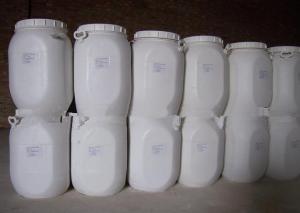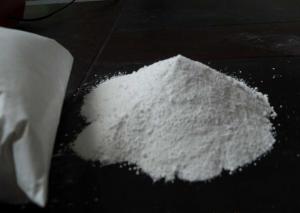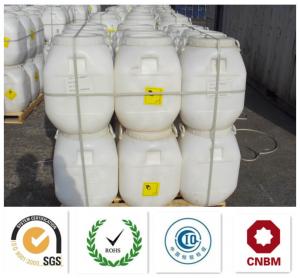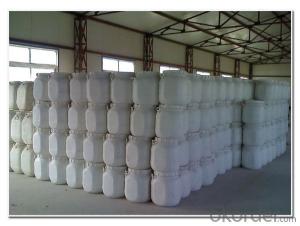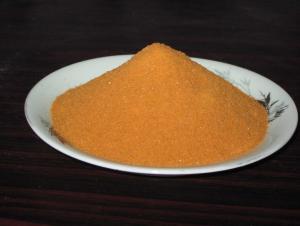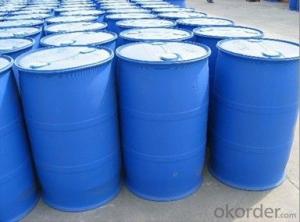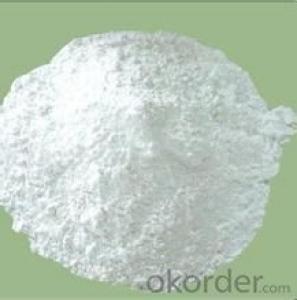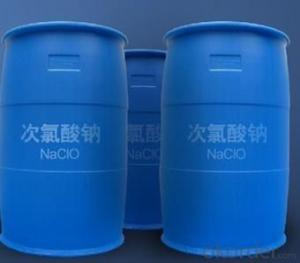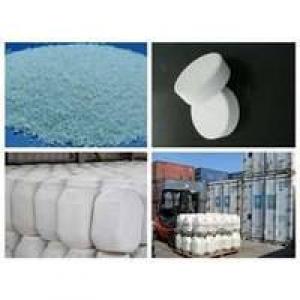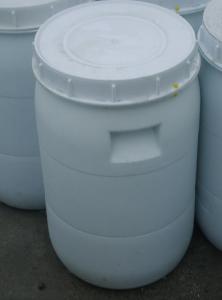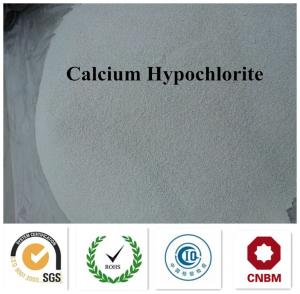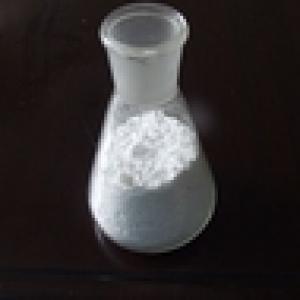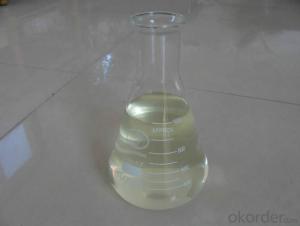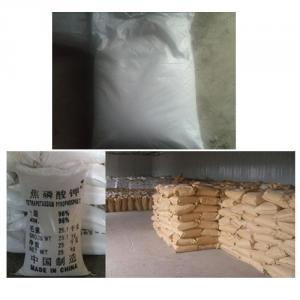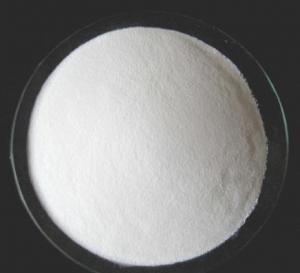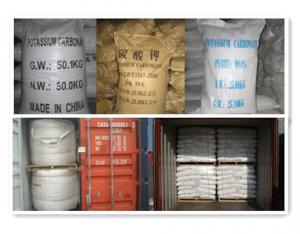Calcium Hypochlorite Calcium and Sodium process
- Loading Port:
- Tianjin
- Payment Terms:
- TT OR LC
- Min Order Qty:
- 25 m.t.
- Supply Capability:
- 2000 m.t./month
OKorder Service Pledge
OKorder Financial Service
You Might Also Like
Calcium Hypochlorite
Introduction:
CNBM GROUP is the biggest water Treatment Factory in China. Our Product include: Calcium Hypochlorite, TCCA, SDIC, PAC, Sodium Sulphite, Sodium Thiosulfate etc.
CNBM One year can produce 18,000MT Calcium Hypochlorite with two model, one is 65% and one is 70%. More important we have 3 advantages, Firstly: High effective chlorine content Secondly: Good stability. Can be stored a long time at normal temperature with little chlorine loss; Third:Good solubility, less water-insoluble matters.
Technical Specifications:
Tablets Forms
Weight | 200 gram | 150gram | 100gram | 50gram | 30gram | 20gram | 15gram | 10gram |
Diameter(mm) | 76 | 70 | 50 | 42 | 30 | 30 | 30 | 30 |
Height(mm) | 25 | 21 | 26 | 27 | 22 | 16 | 12 | 8 |
Applications:
1. For bleaching purpose of wood pulp, silk, cloth and fibre.
2. Disinfection and water-treatment.
3. Disinfectant for chemical poisonous and radioactive substance.
Formula Experiment Design: (Base on 1MT Water)
Constitue Dosage
Calcium Hypochlorite 65% 100kg
Disinfection Liquid 1% Calcium Hypochlorite 65% 1.7g
Shipping Containers:
45—50kg Plastic or Steel Drums with Inner Plastic Bag.
Cautions
1. Should be stored in cool and dry warehouse away from heating sources and avoid direct sunlight.
2. In transportation, contact with such should be avoided as sunlight, heating,moisture, organics, oil and acids.
Other Information please check the MSDS.
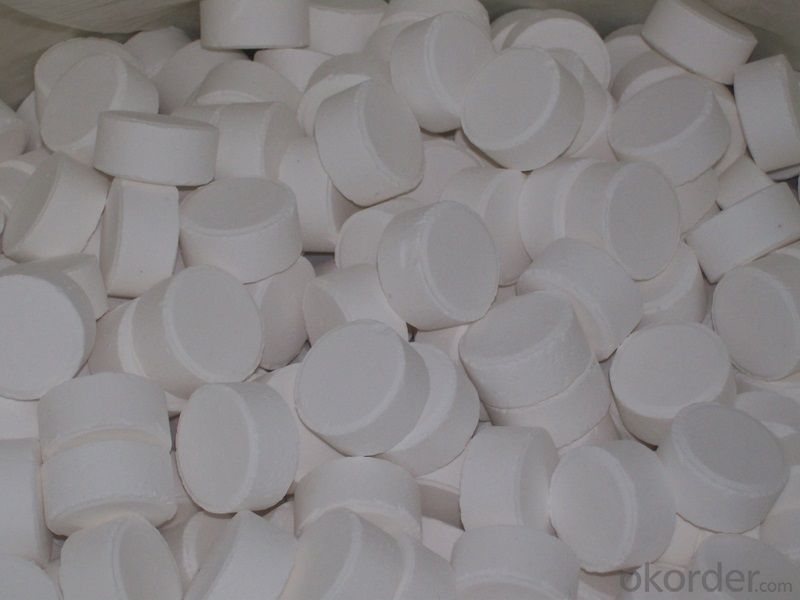
- Q: The effect of inorganic salt medium and the difference with enrichment medium
- The landlord said the basic nutrient base? That is based on the inorganic salt with carbon source and energy sources, such as beef extract, peptone, etc., the basic nutrients can provide the necessary cells to grow cells.
- Q: What is the time when the maximum number of inorganic salts is needed
- Plant inorganic salts are the most nitrogen, phosphorus and potassium containing inorganic salts, if any lack of plant will affect the normal growth.
- Q: Which foods contain calcium-containing inorganic salts
- Calcium and inorganic salts are two concepts, bother you to go back and turn the chemical book and then ask, inorganic salt can eat
- Q: What are the disadvantages of inorganic salt deficiency and too much
- Excessive sodium chloride, will lead to stroke rates and mortality higher than normal, high blood pressure, easy to get high blood pressure. Content is too high, it is easy to cause high sodium and low potassium, and further lead to hypercholesterolemia (potassium can promote steroids, increase vascular elasticity, diuretic, is conducive to improving myocardial contractility, the role of vascular protection);
- Q: Cells are composed of water and inorganic salts or by organic matter and none
- Cells are composed of water and inorganic salts or b
- Q: What is the difference between organic salt and inorganic salt?
- Organic and inorganic chemistry are subdisciplines within chemistry. In organic chemistry, scientific study is concentrated towards carbon compounds and other carbon-based compounds such as hydrocarbons and their derivatives. Read more: www.differencebetween /science...
- Q: As if there are two kinds of nitrogen, phosphorus and potassium, hoping to get answers and explain their respective roles
- (N) Nutrition: Nitrogen is necessary for the growth and development of plants. Usually, the total amount of nitrogen in plants is not too high, such as 1.0-2.0% of the whole plant. The plant is a plant with high nitrogen content, and the nitrogen content in the plant leaves is about 3.5-5.0% of its dry weight.The nitrogen is mainly absorbed in the form of ammonium nitrogen and nitrate nitrogen, and some small molecules of organic nitrogen Such as urea can also be absorbed by plants.Now is the main component of protein, accounting for about 16-18% of the protein content in the cytoplasm and the nucleus are containing all the enzymes are also the main body of the protein.In addition, the nucleic acid, Phospholipids, chlorophyll, coenzyme and other compounds contain nitrogen
- Q: would heterotrophic organism grow well in inorganic salt media? why or why not?
- No. Heterotrophs get energy from the environment in the form of chemical bonds within organic molecules (such as glucose). An inorganic salt medium would not supply the needed organic molecules. Your heterotroph would starve.
- Q: Is the inorganic salt the same as the saline?
- Saline is sodium chloride solution, most people use the point is 0.9%.
- Q: The difference between the ignition of inorganic salts and organic matter
- Calcium is an important part of bones. Calcium deficiency can lead to osteomalacia, osteoporosis and so on. China Nutrition Society recommended 18-50 adult calcium intake of the appropriate daily intake of 800 mg; 50 years old after the elderly taste 1000 mg. Common calcium-rich foods are milk, yogurt, oatmeal, sea cucumber, shrimp, wheat, soybean meal, soy products, lily and so on.
Send your message to us
Calcium Hypochlorite Calcium and Sodium process
- Loading Port:
- Tianjin
- Payment Terms:
- TT OR LC
- Min Order Qty:
- 25 m.t.
- Supply Capability:
- 2000 m.t./month
OKorder Service Pledge
OKorder Financial Service
Similar products
Hot products
Hot Searches
Related keywords
